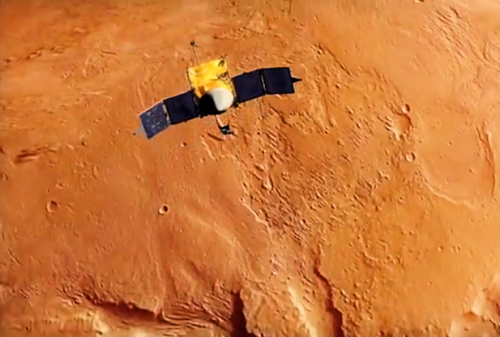 US and India have agreed to enhance cooperation in Mars exploration and establish a pathway for future joint missions to explore the red planet besides launching a NASA-ISRO satellite mission to observe Earth.
US and India have agreed to enhance cooperation in Mars exploration and establish a pathway for future joint missions to explore the red planet besides launching a NASA-ISRO satellite mission to observe Earth.
NASA Administrator Charles Bolden and K. Radhakrishnan, chairman of the Indian Space Research Organisation (ISRO), signed two documents for this purpose in a meeting Tuesday in Toronto, according to media release from the NASA headquarters here.
While attending the International Astronautical Congress, the two space agency leaders met to discuss and sign a charter that establishes a NASA-ISRO Mars Working Group to investigate enhanced cooperation between the two countries in Mars exploration.
They also signed an international agreement that defines how the two agencies will work together on the NASA-ISRO Synthetic Aperture Radar (NISAR) mission, targeted to launch in 2020.
NASA’s contribution to NISAR is being managed and implemented by the agency’s Jet Propulsion Laboratory in Pasadena, California.
“The signing of these two documents reflects the strong commitment NASA and ISRO have to advancing science and improving life on Earth,” said NASA Administrator Charles Bolden.
“This partnership will yield tangible benefits to both our countries and the world.”
The joint Mars Working Group will seek to identify and implement scientific, programmatic and technological goals that NASA and ISRO have in common regarding Mars exploration.
The group will meet once a year to plan cooperative activities, including potential NASA-ISRO cooperation on future missions to Mars.
NASA’s Mars Atmosphere and Volatile EvolutioN (MAVEN) spacecraft arrived at Mars Sep 21 for exploring the tenuous upper atmosphere of Mars.
ISRO’s Mars Orbiter Mission (MOM), India’s first spacecraft launched to Mars, arrived Sep 23 to study the Martian surface and atmosphere and demonstrate technologies needed for interplanetary missions.
One of the working group’s objectives will be to explore potential coordinated observations and science analysis between MAVEN and MOM, as well as other current and future Mars missions.
“NASA and Indian scientists have a long history of collaboration in space science,” said John Grunsfeld, NASA associate administrator for science.
“These new agreements between NASA and ISRO in Earth science and Mars exploration will significantly strengthen our ties and the science that we will be able to produce as a result.”
The joint NISAR Earth-observing mission will make global measurements of the causes and consequences of land surface changes. Potential areas of research include ecosystem disturbances, ice sheet collapse and natural hazards.
NISAR will improve understanding of key impacts of climate change and advance knowledge of natural hazards, NASA said.
NISAR will be the first satellite mission to use two different radar frequencies (L-band and S-band) to measure subtle changes of Earth’s surface associated with motions of the crust and ice surfaces less than a centimetre across.
This allows the mission to observe a wide range of changes, from the flow rates of glaciers and ice sheets to the dynamics of earthquakes and volcanoes.
Under the terms of the new agreement, NASA will provide the mission’s L-band synthetic aperture radar (SAR), a high-rate communication subsystem for science data, GPS receivers, a solid state recorder, and a payload data subsystem.
ISRO will provide the spacecraft bus, an S-band SAR, and the launch vehicle and associated launch services.
The agency developed a partnership with ISRO that led to this joint mission. The partnership with India has been key to enabling many of the mission’s science objectives, NASA said.
NASA and ISRO have been cooperating under the terms of a framework agreement signed in 2008.